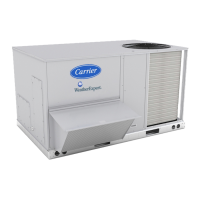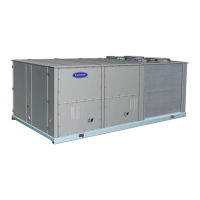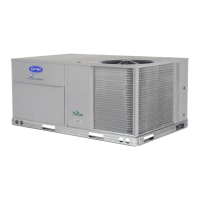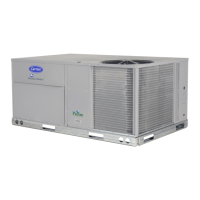79
Control Angle Alarm Configuration
— The economizer ac-
tuator learns what its end stops are though a calibration at the
factory. Field-installed actuators may be calibrated in the Ser-
vice Test mode. When an actuator learns its end stops through
calibration, internally it remembers what its "control angle" is.
From that moment on, the actuator will resolve this control an-
gle and express its operation in a percent (%) of this "learned
range."
If the economizer has not learned a "sufficient" or "large
enough" control angle during calibration, the economizer
damper will be unable to control ventilation and free cooling,
For this reason the economizer actuator used in the N Series
control system has a configurable "control angle" alarm low
limit in its "Economizer Actuator Configs" group, ACT.C.
(C.A.L1, C.A.L2, C.A.L3). If the control angle learned through
calibration is less than C.A.L1, C.A.L2, or C.AL3, an alert will
occur and the actuator will not function.
NOTE: This configuration does not typically need adjustment.
It is configurable for the small number of jobs which may
require a custom solution or workaround.
UNOCCUPIED ECONOMIZER FREE COOLING — This
"Free Cooling" function is used to start the supply fan and use
the economizer to bring in outside air when the outside temper-
ature is cool enough to pre-cool the space. This is done to delay
the need for mechanical cooling when the system enters the oc-
cupied period. Once the space has been sufficiently cooled dur-
ing this cycle, the fan will be stopped.
In basic terms, the economizer will modulate in an unoccu-
pied period and attempt to maintain space temperature to the
"occupied" cooling set point. This necessitates the presence of
a space temperature sensor.
Configuring the economizer for Unoccupied Economizer
Free Cooling is done in the UEFC group. Here you will find
three configuration options, FC.CF, FC.TM and FC.LO re-
spectively.
Unoccupied Economizer Free Cooling Configuration
(FC.CF) — This option is used to configure the "type" of un-
occupied economizer free cooling control that is desired.
0 = disable unoccupied economizer free cooling
1 = perform unoccupied economizer free cooling as available
during the entire unoccupied period.
2 = perform unoccupied economizer free cooling as available,
FC.TM minutes before the next occupied period.
Unoccupied Economizer Free Cooling Time Configuration
(FC.TM) — This option is a configurable time period, prior to
the "next occupied period," that the control will allow unoccu-
pied economizer free cooling to operate. This option is only ap-
plicable when FC.CF = 2.
Unoccupied Economizer Free Cooling Lockout
Temperature (FC.LO) — This configuration option allows the
user to select an outside air temperature, that below which un-
occupied free cooling is disallowed. This is further explained in
the logic section.
Unoccupied Economizer Free Cooling Logic
— There are
qualifications that must be in order for unoccupied free cooling
to operate.
• Unit configured for an economizer
• Unit in the unoccupied mode
• FC.CF set to 1 or FC.CF set to 2 and within FC.TM
minutes of the next occupied period
• Not in the Temperature Compensated Start Mode
• Not in a cooling mode
• Not in a heating mode
• Not in a tempering mode
• Space temperature sensor enabled and sensor reading
healthy
• Outside air temperature sensor healthy
• The economizer would be allowed to cool if the fan were
requested and in a cool mode.
• OAT > FC.LO ( 1.0 dF hysteresis applied)
• The rooftop is not in a fire smoke mode
• No fan failure when configured to shut the unit down on
a fan failure
If all of the above conditions are satisfied:
Unoccupied Economizer Free Cooling shall start when both
of the following conditions are true:
{SPT > (OCSP + 2)} AND {SPT > (OAT + 8)}
The Night Time Free Cooling Mode shall stop when either
of the following conditions are true:
{SPT < OCSP} OR {SPT < (OAT + 3)}
…where SPT = Space Temperature and OCSP = Occupied
Cooling Setpoint
When the Unoccupied Economizer Free Cooling mode is
active, the supply fan is turned on and the economizer damper
modulated to control to the supply air setpoint (Set-
points
SASP) plus any supply air reset that may be applied
(Inputs
RSET
SA.S.R).
OUTDOOR AIR CFM CONTROL — If an outdoor air cfm
flow station has been installed on a N Series rooftop, the econ-
omizer is able to provide minimum ventilation based on CFM,
instead of damper position. The Outdoor Air CFM reading can
be found in Inputs
CFM
O.CFM .
The following options are used to program outside air cfm
control:
Outdoor Air CFM Sensor Enable (
OCF.S) — If this option is
enabled the outdoor air cfm sensor will be read and outside air
cfm control will be enabled.
Economizer Minimum Flow Rate (
O.C.MX) — This "CFM"
configuration option replaces the Economizer Minimum Posi-
tion (EC.MN) when the outdoor air cfm sensor is enabled.
IAQ Demand Vent Minimum Flow Rate (
O.C.MN) — This
"CFM" configuration option replaces the IAQ Demand Venti-
lation Minimum Position (Configuration
IAQ
DCV.C
IAQ.M) when the outdoor air cfm sensor is enabled.
Economizer Minimum Flow Deadband (
O.C.DB) — This
"CFM" configuration option defines the deadband of the CFM
control logic.
During CFM control, the economizer must guarantee a cer-
tain amount of CFM at any time for ventilation purposes. If the
outdoor air cfm measured is less than the current calculated
CFM minimum position, then the economizer will attempt to
open until the outdoor air cfm is greater than or equal to this
cfm minimum position. Now, this configurable deadband helps
keeps the economizer from attempting to close until the out-
door air cfm rises to the current minimum cfm position PLUS
the deadband value. Increasing this deadband value may help
to slow down excessive economizer movement when attempt-
ing to control to a minimum position at the expense of bringing
in more ventilation air then desired.
ECONOMIZER OPERATION CONFIGURATIONS
(WHICH AFFECT FREE COOLING ACTUATOR MOD-
ULATION) — There are configuration items in the E.CFG
menu group that affect how the economizer modulates when
attempting to follow an economizer cooling set point. Typical-
ly, they will not need adjustment. In fact, it is strongly advised
not to adjust these configurations from their default settings
without first consulting a service engineering representative.
In addition, it should be noted that the economizer cooling
algorithm is designed to automatically slow down the econo-
mizer actuator's rate of travel as outside-air temperature de-
creases. See Table 55.

